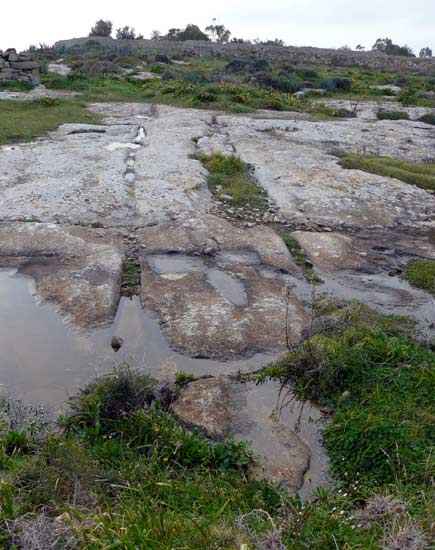

Overlooking the small island of Copinsay

Nice view on one side, washing line on the other

First view of Stembister standing stone, behind the farmhouse

Looking north towards Glastonbury Tor from the interior

I visited Culverwell in 2005 and saw within the shed. My photos were of poor quality due to the light conditions and I’ve refrained from posting any – until now. It seems apparent that not many amateurs get to be shown this site so my efforts must be better than none.

Part of the outer face of the semi-circular wall

Random bloke for scale. Some of the stones in the wall are massive

The inner face of the curvilinear wall

Err....I’m not making this up.
Part of the wall can be seen in the middle left. It goes behind a large cairn which rises to the same height of the wall but is completely separate from the wall. The cross marks a place where the Blessed Virgin Mary (it is claimed) has been making regular appearances.
borgin-nadur.blogspot.com/

The cave as seen from just within the entrance

An area of stratified, sedimentary deposit thoughtfully left unexcavated by the presiding archaeologist. The top-most notice states: Domestic animals layer (cultural layer, pottery layer)

The only remaining decorated stone visible at the Skorba temples

The Guardians of the Temple

The southern arc from the south

The southern line of stones from the north west

The northern row from the south west

The northern line of stones from the north west.

Only a few stones are visible; the others are overwhelmed by trees and prickly pears

The curse of the Malta/Gozo countryside leaves its mark: a temple transformed into a hunter’s hide

Quick! Take a last look before the cover goes on

The “Rock of the Giantess” has her own gated enclosure on Gnien Imrik Street

Group of figurines found within the Xaghra Circle; now on display at Gozo’s Museum of Archaeology

Twin mother goddess statuette with one head missing found in the Xaghra Circle; now on display in the Museum of Archaeology in Victoria

Terracotta head found at Santa Verna, now on display at the Gozo Museum of Archaeology

The remains of the temple are not easy to find. Look for a raised area on the ground and a bird hunter’s hide which uses a standing stone

The curved shape of a temple apse

It is generally agreed this hunter’s hide incorporates a stone from the temple

The cart ruts run close to the cliff edge at this point




















